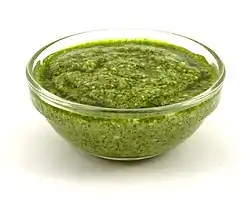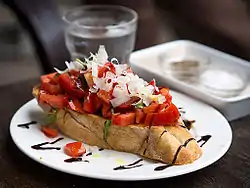Portal:Food/Selected recipe
|
These are the pictures that are featured on the Food portal main page. Please follow the usage instructions listed below when placing a new recipe here, |
Selected content:
Selected content tools:
|
UsageThe template used to create these sub-pages is located at {{Selected recipe}}.
| |
Selected recipe 1

The ratio of ingredients and mixing method determines the texture of the crust. If the flour is not well mixed with the shortening, then water can bind to the available flour causing the gluten protein matrix to become over developed. This would result in a tough crust, as opposed to a flaky crust, which is more desirable. (Full article...)
Selected recipe 2
A French dip sandwich, also known as a beef dip, is a hot sandwich consisting of thinly sliced roast beef (or, sometimes, other meats) on a "French roll" or baguette. It is usually served plain but a popular variation is to top with Swiss cheese, onions, and a dipping container of beef broth produced from the cooking process (termed au jus, "with juice"). Beef stock, a light beef gravy, or beef consommé is sometimes substituted. The sandwich is an American invention, with the name seeming to refer to the style of bread, rather than any French origin. Although the sandwich is most commonly served with a cup of jus or broth on the side of the plate, into which the sandwich is dipped as it is eaten, this is not how the sandwich was served when it was originally developed.
Two Los Angeles restaurants have claimed to be the birthplace of the French dip sandwich: Cole's Pacific Electric Buffet and Philippe the Original. Philippe's website describes the dish as a "specialty of the house", and the words "Home of the Original French Dip Sandwich" are present in the restaurant's logo. At Phillippe's, the roll is dipped in the hot beef juices before the sandwich is assembled, and is served "wet", while at Cole's it is served with a side of beef juices. The sandwich can also be requested "double dipped", where both halves of the sandwich are dipped before serving, at either establishment. Both restaurants feature their own brand of spicy mustard that is traditionally used by patrons to complement the sandwich. (Full article...)
Selected recipe 3
Goan vindaloo or vindalho is an Indian curry dish, which is originally from Goa, based on the Portuguese dish carne de vinha d'alhos. It is known globally in its British Indian form as a staple of curry house and Indian restaurant menus and is often regarded as a fiery, spicy dish. The traditional recipe uses pork, but alternative versions have been prepared with beef, mutton, prawns, chicken, lamb, vegetables and tofu. (Full article...)
Selected recipe 4

Brownies are typically eaten by hand, often accompanied by a glass of milk, served warm with ice cream (à la mode), topped with whipped cream, or sprinkled with powdered sugar and fudge. In North America, they are common homemade treats and they are also popular in restaurants, ice cream parlors and coffeehouses. (Full article...)
Pictured are Oatmeal Stout Brownies. This recipe, created by Joe Stutler, was a national finalist in the 2006 Cooking With Beer Challenge. The malt and oats in the beer enhance the flavor of the chocolate in these delicious brownies. Not overly cake-ey, not overly fudge-ey, the texture is nicely balanced. They're also decadently chocolate, and surprisingly light (thanks to the eggs). Great with a fruity beer, such as a lambic (Framboise, yum!).
Selected recipe 5
Cornbread is a quick bread made with cornmeal, associated with the cuisine of the Southern United States, with origins in Native American cuisine. It is an example of batter bread. Dumplings and pancakes made with finely ground cornmeal are staple foods of the Hopi people in Arizona. The Hidatsa people of the Upper Midwest call baked cornbread naktsi. Cherokee and Seneca tribes enrich the basic batter, adding chestnuts, sunflower seeds, apples, or berries, and sometimes combine it with beans or potatoes. Modern versions of cornbread are usually leavened by baking powder. (Full article...)
Sweet Cornbread is a variant of the Skillet Cornbread made throughout the Southern United States.
Selected recipe 6
Kimchi (/ˈkɪmtʃiː/; Korean: 김치, romanized: gimchi, IPA: [kim.tɕʰi]), is a traditional Korean banchan consisting of salted and fermented vegetables, most commonly using napa cabbage or Korean radish. A wide selection of seasonings are used, including gochugaru (Korean chili powder), spring onions, garlic, ginger, and jeotgal (salted seafood), etc. Kimchi is also used in a variety of soups and stews. Kimchi is a staple food in Korean cuisine and is eaten as a side dish with almost every Korean meal.
There are hundreds of different types of kimchi made with different vegetables as the main ingredients. Traditionally, winter kimchi, called kimjang, was stored in large earthenware fermentation vessels, called onggi, in the ground to prevent freezing during the winter months and to keep it cool enough to slow down the fermentation process during summer months. The vessels are also kept outdoors in special terraces called jangdokdae. In contemporary times, household kimchi refrigerators are more commonly used. (Full article...)
Selected recipe 7

Roux (/ˈruː/) is a mixture of flour and fat cooked together and used to thicken sauces. Roux is typically made from equal parts of flour and fat by weight. The flour is added to the melted fat or oil on the stove top, blended until smooth, and cooked to the desired level of brownness. A roux can be white, blond (darker) or brown. Butter, bacon drippings or lard are commonly used fats. Roux is used as a thickening agent for gravy, sauces, soups and stews. It provides the base for a dish, and other ingredients are added after the roux is complete. (Full article...)
Selected recipe 8
French toast is a dish of sliced bread soaked in beaten eggs and often milk or cream, then pan fried. Alternative names and variants include eggy bread, Bombay toast, gypsy toast, and poor knights (of Windsor).
When French toast is served as a sweet dish, sugar, vanilla, or cinnamon are also commonly added before pan-frying, and then it may be topped with sugar (often powdered sugar), butter, fruit, or syrup. When it is a savory dish, it is generally fried with a pinch of salt or pepper, and it can then be served with a sauce such as ketchup or mayonnaise. (Full article...)
Selected recipe 9
Paella (/paɪˈɛlə/, /pɑːˈeɪjə/, py-EL-ə, pah-AY-yə, Valencian: [paˈeʎa], Spanish: [paˈeʝa]) is a rice dish originally from Valencia. Paella is regarded as one of Valencia's identifying symbols. It is one of the best-known dishes in Spanish cuisine.
The dish takes its name from the wide, shallow traditional pan used to cook the dish on an open fire, paella being the word for a frying pan in Valencian/Catalan language. As a dish, it may have ancient roots, but in its modern form, it is traced back to the mid-19th century, in the rural area around the Albufera lagoon adjacent to the city of Valencia, on the Mediterranean coast of Spain. (Full article...)
Selected recipe 10
Portal:Food/Selected recipe/10

In Vietnamese cuisine, bánh mì or banh mi (/ˈbɑːn miː/, /ˈbæn/; Vietnamese: [ɓǎjŋ̟ mì], 'bread') is a short baguette with thin, crisp crust and a soft, airy texture. It is often split lengthwise and filled with savory ingredients like a submarine sandwich and served as a meal, called bánh mì thịt. Plain bánh mì is also eaten as a staple food.
A typical Vietnamese roll or sandwich is a fusion of meats and vegetables from native Vietnamese cuisine such as chả lụa (Vietnamese sausage), coriander leaf (cilantro), cucumber, pickled carrots, and pickled daikon combined with condiments from French cuisine such as pâté, along with red chili and mayonnaise. However, a wide variety of popular fillings are used, from xíu mại (a Chinese dumpling) to even ice cream. In Vietnam, bread rolls and sandwiches are typically eaten for breakfast or as a snack. (Full article...)
Selected recipe 11
Portal:Food/Selected recipe/11

The muffins pictured are a variation on the classic lemon poppy seed muffin. Made with real lemon zest and covered with a lemon-flavored confectioners glaze, they are an ideal companion for a Sunday brunch.
Selected recipe 12
Portal:Food/Selected recipe/12
Pesto (Italian: [ˈpesto]) is a paste that traditionally consists of crushed garlic, European pine nuts, coarse salt, basil leaves, and hard cheese such as Parmigiano-Reggiano (also known as Parmesan cheese) or Pecorino Sardo (cheese made from sheep's milk), all blended with olive oil. It originated in Genoa, the capital city of Liguria, Italy. (Full article...)
Selected recipe 13
Portal:Food/Selected recipe/13

Selected recipe 14
Portal:Food/Selected recipe/14
Bruschetta (/bruːˈskɛtə/, /bruːˈʃɛtə/, Italian pronunciation: [bruˈsketta] ⓘ) is an antipasto (starter dish) from Italy consisting of grilled bread rubbed with garlic and topped with olive oil and salt. Variations may include toppings of tomato, vegetables, beans, cured meat, or cheese. In Italy, bruschetta is often prepared using a brustolina grill. (Full article...)


.jpg.webp)




